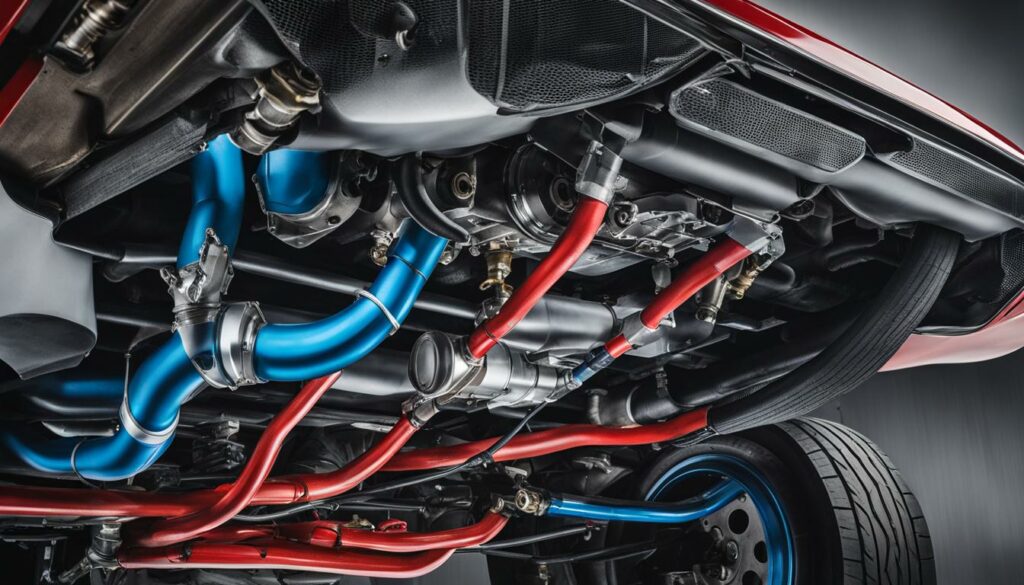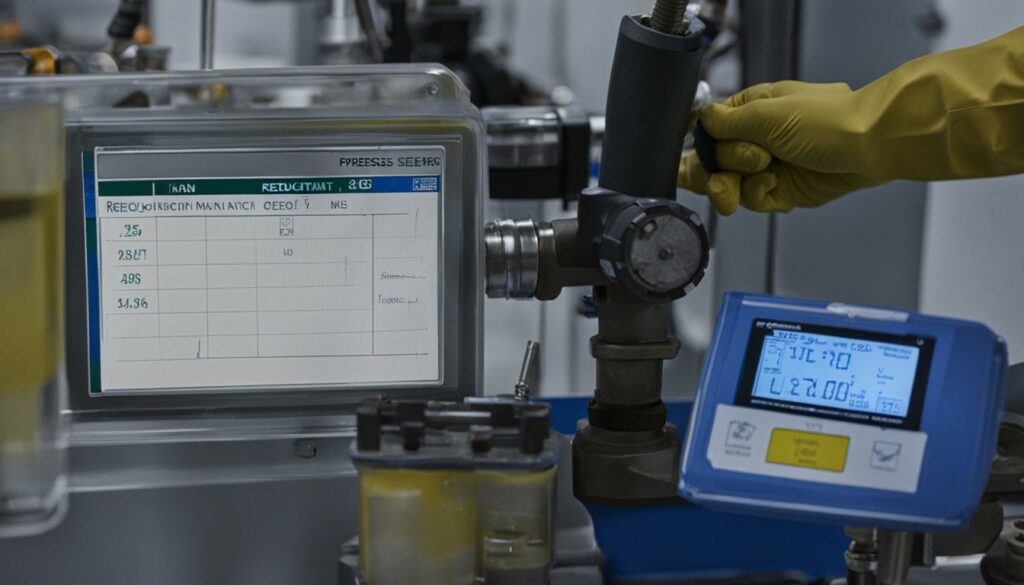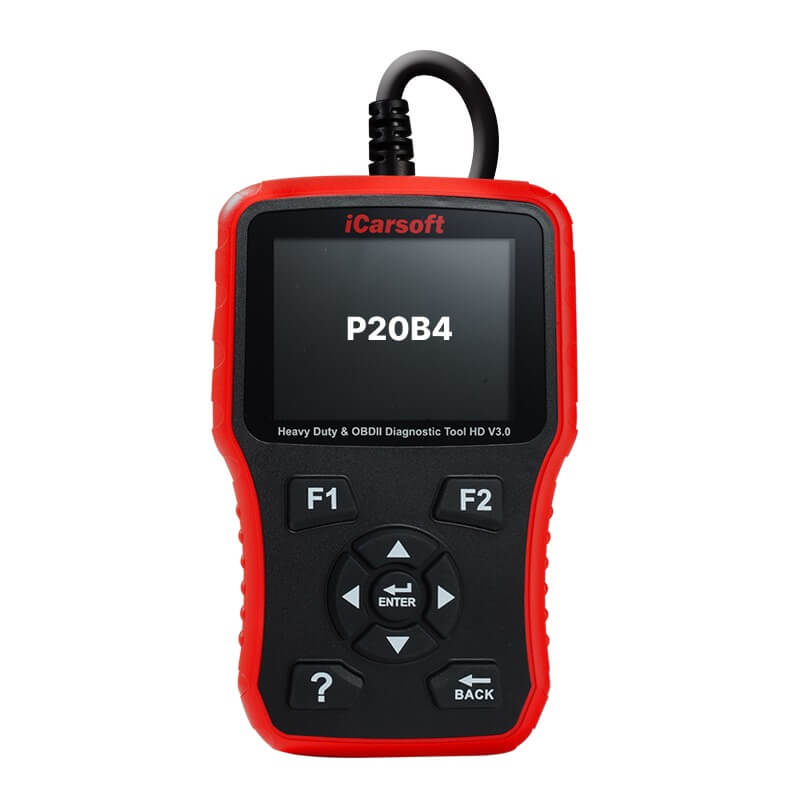P20B4 – Reductant Pressure Plausibility Failure: Diagnosis and Repair
POSTED IN pcodes
Welcome to our article on P20B4 – Reductant Pressure Plausibility Failure, a fault code specific to vehicles equipped with clean burning diesel engines and selective catalytic reduction (SCR) systems. In this article, we will explore the technical description, meaning, severity, symptoms, common causes, troubleshooting steps, and repair options for P20B4. Understanding this fault code is crucial for maintaining the performance and compliance of your vehicle’s reductant system.
Key Takeaways:
- P20B4 is a stored fault code indicating abnormal voltage in the reductant pressure sensor circuit, specific to vehicles with SCR systems.
- This fault code should be considered severe and addressed promptly to prevent potential catalyst damage and comply with emission standards.
- Symptoms of P20B4 may include reduced fuel efficiency, excessive black smoke from the exhaust, and diminished engine performance.
- Common causes of P20B4 include a defective reductant pressure sensor, open or shorted circuits, and malfunctioning SCR controller/PCM.
- To diagnose and repair P20B4, a diagnostic scanner, DVOM, and access to vehicle-specific diagnostic information are essential.
What is Reductant Pressure Plausibility Failure?
Reductant Pressure Plausibility Failure (P20B4) is a fault code that indicates an issue with the reductant pressure in the Selective Catalytic Reduction (SCR) system. This code is specific to vehicles with clean burning diesel engines equipped with SCR systems. The SCR system injects a reductant compound into the exhaust to reduce harmful emissions. The reductant pressure sensor is responsible for monitoring the pressure of the reductant. When the reductant pressure plausibility fails, it can result in various symptoms affecting the fuel efficiency, engine performance, and emission control of the vehicle.
- Reduction in fuel efficiency
- Excessive black smoke from the exhaust
- Diminished engine performance
- Presence of other related SCR fault codes
It is crucial to address this code promptly to prevent further damage to the catalyst and the exhaust system. Additionally, resolving this issue is necessary to ensure that the vehicle complies with emission standards. By diagnosing and repairing the reductant pressure plausibility failure, optimal engine performance, fuel efficiency, and emission control can be restored.
When facing a P20B4 fault code, it is recommended to consult with a professional automotive technician or mechanic who is experienced in dealing with SCR-related codes. They will have the expertise and tools required to accurately diagnose the issue and perform the necessary repairs or component replacements.
| Symptoms | Causes | Diagnostic Steps | Repair Options |
|---|---|---|---|
|
|
|
|
Causes of P20B4 – Reductant Pressure Plausibility Failure
The common causes of a P20B4 fault code include a defective reductant pressure sensor, open or shorted circuits in the reductant pressure sensor system, and a malfunctioning SCR controller/PCM. Programming errors can also contribute to this fault code. It is recommended to thoroughly diagnose each potential cause to accurately determine the root of the problem before proceeding with repairs.
Buy tested tuning file for Adblue / EGR / DPF / Adblue off now!
A defective reductant pressure sensor can lead to erroneous pressure readings, causing the PCM to trigger the P20B4 fault code. This sensor is responsible for monitoring the pressure of the reductant, and any malfunctioning or inaccurate readings can result in the fault code being stored.
Open or shorted circuits in the reductant pressure sensor system can disrupt the flow of electrical signals, leading to incorrect sensor readings. These circuit issues can be caused by damaged wiring, loose connections, or corrosion. Thoroughly inspecting the circuits and repairing any faults is crucial to resolving the P20B4 fault code.
The SCR controller or PCM, which controls the operation of the SCR system, can also contribute to the P20B4 fault code. Malfunctions or programming errors within these components can cause improper operation, leading to the fault code being triggered. Diagnosing and repairing any issues with the SCR controller or PCM may be required to resolve the P20B4 fault code.

To accurately diagnose the causes of the P20B4 fault code, a comprehensive scan tool capable of reading manufacturer-specific codes, freeze frame data, and live data streams is necessary. Additionally, using a digital volt/ohmmeter (DVOM) to test the electrical circuits and components can help identify any open or shorted circuits. Thoroughly inspecting the reductant pressure sensor, circuits, and SCR controller can help pinpoint the root cause of the fault code and guide the appropriate repairs.
Symptoms of P20B4 – Reductant Pressure Plausibility Failure
When encountering a P20B4 fault code related to reductant pressure plausibility failure, it is crucial to be aware of the accompanying symptoms. Recognizing these symptoms can prompt immediate action to diagnose and resolve the underlying issue, ensuring optimal vehicle performance and compliance with emission standards.
- Reduction in fuel efficiency: One of the noticeable symptoms of a P20B4 fault code is a decrease in fuel efficiency. If you notice that your vehicle is consuming more fuel than usual, it could be a sign of reductant pressure plausibility failure.
- Excessive black smoke from the exhaust: Another indication of a potential P20B4 fault code is the presence of excessive black smoke coming from the exhaust. This can be a warning sign that the reductant pressure system is not functioning correctly.
- Diminished engine performance: A P20B4 fault code can also affect the engine’s performance. You may experience a decrease in power, rough idling, or engine misfires. These issues can impact the overall driving experience and should not be ignored.
- Presence of other related SCR fault codes: It’s important to note that a P20B4 fault code may be accompanied by other related SCR fault codes. These additional codes can provide further insight into the specific issues affecting the reductant pressure system.
To offer a visual representation of the symptoms associated with P20B4 – Reductant Pressure Plausibility Failure, the table below highlights the key indicators and their significance:
| Symptom | Description |
|---|---|
| Reduction in fuel efficiency | Increased fuel consumption, lower mileage per gallon |
| Excessive black smoke from the exhaust | Visible emission of dark exhaust fumes |
| Diminished engine performance | Loss of power, rough idling, engine misfires |
| Presence of other related SCR fault codes | Additional fault codes related to SCR system malfunction |
These symptoms should not be ignored, as they serve as early warning signs of potential issues with the reductant pressure system. Taking proactive steps to diagnose and resolve the root cause of this fault code can prevent further damage to the vehicle and ensure compliance with emission regulations.
Diagnostic Steps for P20B4 – Reductant Pressure Plausibility Failure
When encountering a P20B4 fault code indicating reductant pressure plausibility failure, it is essential to follow systematic diagnostic procedures for accurate identification and resolution of the issue.
Step 1: Retrieve Diagnostic Trouble Codes and Freeze Frame Data
Utilize a diagnostic scanner to retrieve all stored codes and freeze frame data related to the P20B4 fault code. This information will provide valuable insights into the specific conditions and system parameters at the time the fault code was triggered.
Step 2: Document and Clear Codes
Before clearing any codes, make sure to document the retrieved diagnostic trouble codes and freeze frame data. This documentation will serve as reference material throughout the diagnostic process. After documentation, clear the codes and perform a test drive to determine if the P20B4 fault code resets or if the PCM enters readiness mode.
Step 3: Reference Diagnostic Flow-Charts and Connector Charts
Consult diagnostic flow-charts, connector pin-out charts, and connector face views specific to the vehicle model and year. These resources will guide you in conducting comprehensive testing of the reductant pressure sensor and the input/output signal circuits.
Step 4: Test the Reductant Pressure Sensor
Using a digital volt/ohmmeter (DVOM), perform tests on the reductant pressure sensor according to the component testing procedures and specifications provided in the diagnostic flow-charts. This will help determine the functionality and accuracy of the sensor.
Step 5: Test the Input/Output Signal Circuits
Continuing with the DVOM, assess the input/output signal circuits connected to the reductant pressure sensor. Follow the procedures outlined in the diagnostic flow-charts to ensure proper functioning and integrity of these circuits.
Tip: When testing the input/output signal circuits, pay close attention to any signs of open or shorted circuits. These issues can contribute to the P20B4 fault code and should be addressed accordingly.
| Diagnostic Steps for P20B4 – Reductant Pressure Plausibility Failure | Description |
|---|---|
| Step 1: Retrieve Diagnostic Trouble Codes and Freeze Frame Data | Use a diagnostic scanner to retrieve stored codes and freeze frame data related to the fault code. |
| Step 2: Document and Clear Codes | Document the retrieved codes and freeze frame data before clearing them. Clear the codes and perform a test drive. |
| Step 3: Reference Diagnostic Flow-Charts and Connector Charts | Consult diagnostic flow-charts and connector charts specific to the vehicle model and year. |
| Step 4: Test the Reductant Pressure Sensor | Use a DVOM to test the reductant pressure sensor according to provided procedures and specifications. |
| Step 5: Test the Input/Output Signal Circuits | Continue with the DVOM to assess the input/output signal circuits connected to the sensor. |
By diligently following these diagnostic steps, you can effectively pinpoint the root cause of the P20B4 fault code and take appropriate measures to resolve the reductant pressure plausibility failure.

Repair Options for P20B4 – Reductant Pressure Plausibility Failure
When facing a P20B4 fault code indicating reductant pressure plausibility failure, it is essential to consider the available repair options. Seeking professional assistance is highly recommended to ensure a thorough diagnosis and reliable repair of the underlying issue. Professionals possess the expertise and specialized tools required to accurately identify and resolve the problem, minimizing the risk of further complications.
However, in situations where professional assistance is unavailable or not feasible, there is an alternative option to address the P20B4 fault code. This option involves the permanent removal of the specific fault code by uploading the Engine Control Unit (ECU) file to a designated portal. By eliminating the code from the ECU, the recurring fault indication can be permanently removed.
It is important to note that while this alternative option provides a solution to eliminate the fault code, it does not address potential underlying issues with the reductant pressure system. Thus, it is recommended to exercise caution and consider subsequent troubleshooting and repairs if necessary to ensure the optimal performance of the vehicle’s reductant pressure system.
Severity of P20B4 – Reductant Pressure Plausibility Failure
A P20B4 fault code should be considered severe and addressed as quickly as possible. The SCR system could be disabled due to this fault code, and if left unresolved, catalyst damage may occur. It is crucial to resolve this issue promptly to comply with emission standards and prevent further damage to the vehicle’s exhaust system.
Impact of Disabled SCR System
When the SCR system is disabled due to a P20B4 fault code, the vehicle’s ability to reduce harmful emissions is compromised. The reductant compound, responsible for neutralizing pollutants in the exhaust gases, is not injected into the exhaust stream. As a result, the emissions released into the atmosphere do not meet the required standards, contributing to increased air pollution. Additionally, the disabled SCR system can lead to decreased fuel efficiency and poor engine performance.
Potential Catalyst Damage
If a P20B4 fault code is not addressed promptly, it can lead to catalyst damage. The catalyst, located within the exhaust system, plays a crucial role in converting harmful gases into less harmful substances. Without the proper functioning of the SCR system and reductant pressure, the uncontrolled release of pollutants can cause the catalyst to overheat and deteriorate over time. This can result in reduced efficiency and costly repairs to replace the damaged catalyst.
Compliance with Emission Standards
Resolving the P20B4 fault code is essential to comply with emission standards set by regulatory bodies. These standards are in place to ensure that vehicles meet strict environmental requirements and minimize the impact on air quality. Failure to address the fault code can result in non-compliance and potential penalties. By promptly addressing the issue and restoring the SCR system to its proper functioning, vehicle owners can ensure their vehicles are in alignment with emission standards and help preserve the environment.
Risks of Ignoring the Issue
“Disregarding the severity of a P20B4 fault code can have detrimental consequences for both the environment and the vehicle. It is important to recognize the significance of this issue and take proactive measures to resolve it promptly.”
| Severity | Impact |
|---|---|
| Disabled SCR System | Increased air pollution, reduced fuel efficiency, poor engine performance |
| Catalyst Damage | Reduced efficiency, costly repairs |
| Non-compliance with Emission Standards | Potential penalties, regulatory fines |
Conclusion
In conclusion, addressing the P20B4 fault code for reductant pressure plausibility failure is of utmost importance. Swift diagnosis and repair are essential to ensure the proper functioning of the SCR system and to maintain compliance with emission standards. Ignoring this fault code can lead to severe consequences, such as disabled SCR systems and potential catalyst damage.
Seeking professional assistance or exploring alternative options, such as permanently removing the fault code through ECU file uploads, can effectively resolve the issue. Regular maintenance and diligent monitoring of the reductant pressure system are also crucial in preventing the recurrence of this fault code and ensuring optimal vehicle performance.
By addressing the P20B4 fault code promptly and proactively maintaining the reductant pressure system, we can contribute to cleaner air and a healthier environment while preserving the longevity and efficiency of our diesel engines.
FAQ
What is a P20B4 fault code?
A P20B4 fault code indicates a reductant pressure plausibility failure in the SCR system of vehicles with clean burning diesel engines equipped with selective catalytic reduction (SCR) systems.
What are the symptoms of a P20B4 fault code?
Symptoms of a P20B4 fault code may include a reduction in fuel efficiency, excessive black smoke from the exhaust, diminished engine performance, and the presence of other related SCR fault codes.
What are the common causes of a P20B4 fault code?
The common causes of a P20B4 fault code include a defective reductant pressure sensor, open or shorted circuits in the reductant pressure sensor system, and a malfunctioning SCR controller/PCM. Programming errors can also contribute to this fault code.
How is a P20B4 fault code diagnosed?
Diagnosing a P20B4 fault code requires a diagnostic scanner, a digital volt/ohmmeter (DVOM), and access to vehicle-specific diagnostic information. The diagnostic scanner is used to retrieve all stored codes and freeze frame data, while the DVOM is used to test the reductant pressure sensor and the input/output signal circuits.
What are the repair options for a P20B4 fault code?
It is recommended to seek professional assistance for a thorough diagnosis and repair. If professional assistance is unavailable, there is an alternative option to permanently remove this specific fault code by uploading the Engine Control Unit (ECU) file to a designated portal. However, this may not address potential underlying issues with the reductant pressure system.
How severe is a P20B4 fault code?
A P20B4 fault code should be considered severe as it can disable the SCR system and potentially cause catalyst damage. It is crucial to resolve this issue promptly to comply with emission standards and prevent further damage to the vehicle’s exhaust system.


